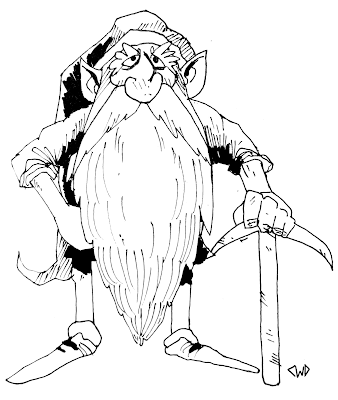AC 3 [16], HD: 14* (63 hp), Att: 1 x bite (3d6) or 1 x squeeze (2d10 hull damage) or breath, THAC0 9 [+10], MV: swim 240’ (80’), SV D8 W9 P10 B10 S12 (7), ML 9, AL Neutral, XP 1,350, NA 1, TT H + pearl
Breath Weapon: 100’ line of pressurized water (save vs. breath or be pushed). The sea dragon must spend one combat turn swallowing water to use this attack again.
Lunge: Up to 40’ out of water to use bite attack.
Squeeze: Coil around and crush a vessel (of equal size or smaller).
Sea Serpents, Fish Drakes, Water Dragons. These piscine behemoths claim vast swathes of ocean as their territory. While they tend to be non-aggressive, the sea dragons hold a strict code of etiquette one must follow to pass through their waters; throw offerings of treasures and fresh meat overboard and you may proceed safely.
These dragons were originally known as “sea kings” because of how other aquatic animals behave around them in nature. The other creatures do not avoid the sea dragon, instead they live alongside it, treating it almost like an alpha of their pack. The other creatures give the dragon a wide berth and allow it first pick of the food. In exchange, they are protected from larger predators; like peasants paying tribute to their lord.
Some more intelligent animals like octopi and dolphins have been seen to offer tribute to the dragon in the form of shiny trinkets and shells.
Every sea dragon naturally forms a pearl beneath its tongue that grows larger as the dragon ages. These pearls are believed to contain the dragon’s spirit, and there are many rumors surrounding their magical powers.
Sailors believe that the pearls can be used to control the dragons, or to harness their power over the seas. The dynasties of the west peddle the belief that they can use dragon pearls in a secret ritual to transform themselves into sea dragons to defend their coastlines from invaders, and the imperial family keeps a dragon pearl as an heirloom.
If you are suicidal enough to want to steal a sea dragon’s treasure, their lairs are found in great shipwrecks, ancient Atlantean ruins, or inside towering pillars of coral, all teeming with beautiful and dangerous sea life.
When a sea dragon discovers some of its hoard has been stolen, miles of ocean are made impassable. The angry dragon sets the sea to boil, stirring up tall dark waves and attacking vessels indiscriminately. The only way to stop it is to return the stolen treasure or slay the beast.
Dream Dragon
Fleshy, wingless dragons with greenish scales and crystalline growths that spend most of their lives asleep. They dwell in crystal-laden caverns.
AC: 3 [16], HD: 6** (20hp), Att: [2 x claw (1d4), 1 x bite (2d8)] or breath, THAC0: 14 [+5] MV: 90’ (30’)/240’ (80’) flying, SV: D10 W11 P12 B13 S14 (6), ML 8, AL Neutral, XP 725, NA: 1 TT: F + crystal growths
Breath Weapon: Cloud of sleep gas (50’ long, 40’ wide, 20’ high, save vs. breath or fall asleep for 4d4 turns). Can be used up to 3 times per day.
Sleeping: 60%. If asleep, may be attacked for one round with a +2 bonus to hit.
Manifest Dreams: While asleep, the dragon’s dreams manifest in the physical world as illusions that disappear when touched.
Telepathy: Can communicate telepathically within 60'.
Credit where it's due, I ran my players through Gavin Norman’s new adventure The Incandescent Grottoes which featured the crystal-eating dream dragon. I liked the idea so much that I decided to expand on it here and draw my own interpretation, seen above.
Dream Dragons are some of the most naturally skilled dreamers in the world. When they dream, their psychic manifestations are so strong that they become visible in our world as phantasms. Sometimes their dreaming can be so strong as to pull creatures from the Dreamlands from their reality into our own.
Usually, dream dragons will settle to feed on crystals. They might not be tasty, but the crystals provide the dragon with much needed mental clarity. In addition, they cannot properly digest the crystals, so what results is a strange sort of symbiosis. The crystals grow within the dream dragon’s body, growing outwards and appearing first as wart-like bumps on the dragon’s skin before piercing through as fully-formed crystals.
The prismatic fumes that the dream dragon exhales induces a deep sleep of vivid, often prophetic dreams. People subjected to the fumes have described the transition as almost seamless: “One instant you’re standing in front of the beast, and the next you’re at the helm of a silver ship, sailing on the clouds among floating islands.”
Despite their fleshy bodies and lack of wings, dream dragons can actually fly. To do so, they take in a huge gulp of air, letting it fill their body as they stretch to their full length and twist through the air like a windsock. Close the dragon’s mouth, and it will crash in a heap.
Dream dragons are intelligent, and their mastery over their own minds allows them to speak telepathically. They have been known to ally themselves with adventurers, getting favors from them in exchange for cryptic prophesies of the near future, knowledge of their surroundings, and rare spells captured from the dream realm.
It would be wise to not make an enemy of a dream dragon, for if left alive, it will make sure you never have a good night's sleep again. They will corrupt your dreams with rogue nightmares and in extreme cases, abduct your psyche and maroon it in the dreamlands that you might never wake...or that something else wakes in your place.




